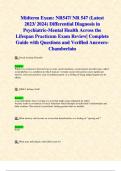Midterm Exam: NR547 / NR 547 ( Latest 2023/ 2024) Differential Diagnosis in Psychiatric -Mental Health Across the Lifespan Practicum Exam Review| Complete Guide with Questions and Verified Answers - Chamberlain Q: Social Anxiety Disorder Answer: While it is common to feel nervous in some social situations, social anxiety disorder (also called social phobia) is a condition in which typical, everyday social interactions cause significant anxiety, self -consciousness, fear of embarrassment, or a feeli ng of being judged negatively by others. Q: DSM -5 defines SAD Answer: as an individual's fear of acting in a way that might cause judgment by others Anxiety leads to avoidance of social situations which disrupts an individual's relationships and daily routines. The anxiety is persistent, lasting greater than six months. Q: What anxiety can become so severe that derealization, or a feeling of "spacing out"? Answer: SAD Q: What may individuals with SAD resort to? Answer: Drugs or alcohol to reduce social inhibitions Q: In the past year SAD has impacted approximately ____% of adults and _____% of adolescents Answer: 7, 9 Q: Risk Factors for SAD Answer: HX of abuse or Neglect Close relative with SAD Q: SAD causes distress in what kind of social situations? Answer: Making small talk with other Meeting new people Performing in front of other (called performance anxiety) Q: Greta who is clingy to her mom when meeting adults but does not have anxiety in peer setting. Would this meet DSM -5 criteria? Answer: Greta displays anxiety when meeting adults in a social situation. Her anxiety is expressed as clinging to her mother and not speaking. The anxiety has been present for several years; however, Greta does not have anxiety in peer settings. Therefore, she doe s not meet DSM -5 criteria for social anxiety disorder Q: Panic attacks Answer: is a brief episode of acute anxiety during which an individual develops an intense fear of negative outcomes accompanied by a feeling of imminent danger. Panic attacks can be unpredictable, often occurring in familiar places where there are no apparent thr eats. The feelings are often accompanied by physiological symptoms. While symptoms typically peak within ten to twenty minutes, some may last for hours Q: Physical symptoms of a panic attack include? Answer: Palpitations, pounding heart, or accelerated heart rate Trembling or shaking Paresthesias (numbness or tingling sensations) Sensation of shortness of breath or smothering Derealization (feelings of unreality) or depersonalization (feeling detached from oneself) Feeling of choking Feeling of chest pain or discomfort Nausea or abdominal stress Feeling dizzy, unsteady, light -headed or faint Chills or heat sensations Q: Panic disorder Answer: occurs when a person experiences repeated panic attacks, usually accompanied by fears about future attacks. Anxiety about future attacks may lead to behavioral changes to avoid situations that might trigger attacks Q: Fabrizia is a 27 -year-old graphic designer who presents to the clinic two months after an emergency department visit for complaints of chest pain, palpitations, nausea, and dizziness. Her electrocardiogram (ECG) and cardiac enzyme panels showed no abnormal ities. She states that the symptoms began while she was watching a movie with her boyfriend and lasted about 15 minutes. She has never experienced anything like this in the past, but since the episode, she has worried occasionally about the symptoms recurring, as her father died of a heart attack at age 45. Based on the DSM -5-TR, does Fabrizia meet diagnostic criteria for panic disorder? A) Yes B) No Answer: B) No Rationale: Fabrizia meets diagnostic criteria for a panic attack, but not for panic disorder. During her panic attack, she reported having four cardinal symptoms associated with a panic attack. She has only had one panic attack, and although she has expres sed worry about symptoms recurring, it is not persistent concern or worry. Q: Phobia Answer: phobia is an intense fear of a specific situation or object. The fear associated with a phobia is not in proportion to the actual danger associated with the situation or object. The prevalence of specific phobias is approximately 8%. Specific phobias often occur after experiencing or witnessing a traumatic event and typically develop in childhood. Clients who have specific phobias often fear more than one object or situation. Each specific phobia is diagnosed separately Q: Ella is a 17 -year-old who presents to the clinic with her mother. Her mom reports that Ella will not go to the basement in their home, and she is concerned about the behavior. During the interview, Ella confirms that even thinking about going to the baseme nt causes her extreme anxiety because she knows that there are spiders in the basement. She has had her phone taken away in the past because she will not go to the basement to gather her laundry, but she states, "I will take the punishment because it is be tter than being around those spiders." She states she has been afraid of spiders for as long as she can remember Which of the following is the most appropriate ICD -10-CM code for Ella? 40.2 Specific phobias 40.218 Specific phobia - animal F40.298 Other specified phobia F40.9 Phobia, phobic




